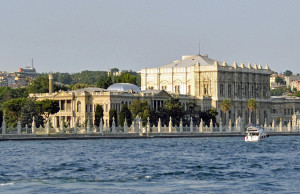By the middle of the nineteenth century, the Ottoman Empire was beginning to experience the economic stresses that led to its becoming known as the “Sick Man of Europe.” To convince his subjects and European monarchs that things were not as bad as they appeared, in 1843 Sultan Abdülmecid II began building an opulent palace on a 61-acre site on the European bank of the Bosporus. The Western-style Dolmabahçe Palace was named for a garden that once occupied the site. When completed in 1856, the palace included three sections, one for administration, one for receiving visitors, and one a harem for the wives and concubines of the Sultan. The 500,000 square feet of useable space included 285 rooms, 43 toilets and six Turkish baths, one incorporating Egyptian alabaster. Fourteen tons of gold and six tons of silver adorned the palace, which also showcased Baccarat crystal and Venetian glass. The ceremonial hall featured a 4.5-ton chandelier, the largest in Europe.
The Dolmabahçe Palace cost the equivalent of 35 tons of gold, 25 percent of the Ottoman Empire’s annual revenue. The Sultan financed this extravagance and the expense of his simultaneous involvement in the Crimean War with foreign loans, contributing to the eventual collapse of his Empire. When Atatürk founded the Turkish Republic in 1923, he used the Dolmabahçe Palace as his summer residence.
The Dolmabahçe Palace and its magnificent riverside grounds are available for guided tours. Visitors ascend a staircase with crystal balusters to view its many splendors, including a bedroom in the harem where Atatürk died on November 10, 1938. The bedroom clock is forever stopped at 9:05 A.M., the minute of Atatürk’s death.

Comments are closed.